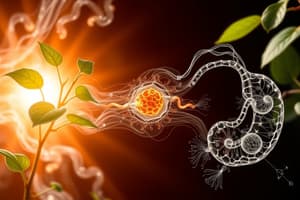Podcast
Questions and Answers
What is the primary source of energy for most living organisms?
What is the primary source of energy for most living organisms?
- Water
- Glucose
- Oxygen
- Sunlight (correct)
Which process converts sunlight, water, and carbon dioxide into glucose and oxygen?
Which process converts sunlight, water, and carbon dioxide into glucose and oxygen?
- Fermentation
- Cellular Respiration
- Osmosis
- Photosynthesis (correct)
Which molecule serves as a source of energy in cellular respiration?
Which molecule serves as a source of energy in cellular respiration?
- Glucose (correct)
- ATP
- Carbon Dioxide
- Oxygen
During which stage of cellular respiration does glycolysis occur?
During which stage of cellular respiration does glycolysis occur?
What is the main function of osmosis in living organisms?
What is the main function of osmosis in living organisms?
Which process involves breaking down glucose to produce ATP?
Which process involves breaking down glucose to produce ATP?
What is the driving force for water movement in osmosis?
What is the driving force for water movement in osmosis?
How do cells prevent osmotic imbalances?
How do cells prevent osmotic imbalances?
Which process generates glucose as a product?
Which process generates glucose as a product?
What is a reactant for photosynthesis?
What is a reactant for photosynthesis?
Which process releases carbon dioxide as a byproduct?
Which process releases carbon dioxide as a byproduct?
Why is osmosis important for the functioning of photosynthesis and cellular respiration?
Why is osmosis important for the functioning of photosynthesis and cellular respiration?
Flashcards are hidden until you start studying
Study Notes
Sustaining Life through Essential Processes
Life on Earth thrives through a series of interconnected processes that ensure energy production, waste removal, and maintenance of cellular environments. Three of these fundamental processes—photosynthesis, cellular respiration, and osmosis—are indispensable for sustaining life as we know it.
Photosynthesis: Harvesting Energy from Sunlight
Photosynthesis is the process by which plants, algae, and some bacteria convert sunlight, water, and carbon dioxide into glucose (sugar) and oxygen. The glucose serves as a source of energy and building blocks for biomolecules, while the oxygen is released into the atmosphere, making it available for other organisms. Photosynthesis is a cornerstone of life on our planet, as it provides the primary source of energy for most living organisms, including the base of the food chain.
Cellular Respiration: Breaking Down Food for Energy
Cellular respiration is the process by which cells break down glucose and other organic molecules to produce energy in the form of ATP (adenosine triphosphate). This process occurs in three stages: glycolysis, the citric acid cycle (also known as the Krebs cycle or TCA cycle), and oxidative phosphorylation. Much like a car converting fuel into motion, cellular respiration converts glucose into energy that cells can use to perform various functions.
Osmosis: Balancing Water and Solute Concentrations
Osmosis is the process by which water moves from an area of higher water concentration to an area of lower water concentration, driven by a concentration gradient. Osmosis plays a critical role in maintaining the water balance and cellular homeostasis in living organisms. Cells regulate the concentration of solutes inside and outside their membranes to prevent osmotic imbalances, which could lead to cell shrinkage or swelling, and potential cell death.
Cross-connections between Processes
The three processes discussed above are interconnected and essential for the maintenance of life. Photosynthesis generates glucose, which fuels cellular respiration, while cellular respiration releases carbon dioxide, which is a reactant for photosynthesis. Osmosis helps maintain the balance of water and solutes in cells, essential for the proper functioning of photosynthesis and cellular respiration.
The Bigger Picture
Understanding these fundamental processes provides insight into the interconnectedness of life on Earth and the vital role each plays in sustaining it. Photosynthesis and cellular respiration, along with the many other metabolic processes that occur in living organisms, allow for the conversion of energy, water, and nutrients into the building blocks of life. Osmosis ensures that cells can maintain their water balance and remain functional. Together, these processes enable the growth, development, and reproduction of life on our planet.
In summary, photosynthesis, cellular respiration, and osmosis are essential processes that sustain life on Earth. Understanding these processes provides a solid foundation upon which to build a comprehensive understanding of biological systems and their functions.
Studying That Suits You
Use AI to generate personalized quizzes and flashcards to suit your learning preferences.




